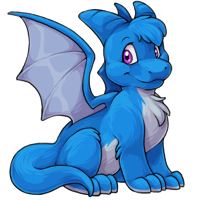


Dragarth
(drah-GARTH)
Thousands of years ago, dragarths roamed around Subeta as wild as their dragon brethren – until they realized the pampered life of a pet was far better than hunting for food and sleeping in caves. In turn, Subetans realized that dragarths were not only a useful pet to have around, but were quite gentle and… well, cute. Generation after generation of dragarth became so accustomed to the domesticated life that fewer and fewer were seen living in the wild. These days, Subetans will not find a dragarth in the wild, but they will find plenty of them living the happy home life!
The smallest of the four known dragon species on Subeta, dragarths stand between 18-24 inches (46-61 cm) and weigh between 35-50 lbs (16-22.6 kg), with the males being a bit larger and heavier. They are covered nearly from head to toe in a soft, heavy fur that feels similar to down feathers. Before dragarths were fully domesticated, they were found mostly in the remote mountains, and the fur served as protection from the elements for these cold-blooded creatures. They are equally comfortable on the ground as well as in the air, and although they are not the fastest flyers, their compact frame allows them to navigate around obstacles that their larger distant relatives have trouble with. Dragarths are obligate carnivores that need a high protein, meat-rich diet. They are especially fond of mallarchy eggs (raw or cooked) as well as organ meat.
Like many domesticated animals, dragarths will breed year-round, although the season peaks near the end of summer. Dragarths are a live-bearing species, having anywhere from 3-6 fluffy, cotton-soft babies in a single litter. These babies, known as “scamps” for their playful and mischievous natures, are born fully-furred and able to eat solid meat within hours of birth. They are ready to be separated from their mothers around 5-6 weeks, although it can take several months for their wings to fully develop.
Dragarths are relatively easy to keep as pets. They take readily to training, including housetraining and leash training. They love to play games, particularly fetch - and dragarth owners never have to worry about a ball getting lost on the roof. They do require a lot of grooming, especially for those in warmer climates, and they should be exercised on a regular basis. Their horns are covered in a soft, velvet-like fur, and they love to scratch them on various surfaces like tree trunks or even rough rocks - and no dragarth will turn down a good scratch on the head from their owner, either!
Dragarth has been viewed 4,166 times.
[Search]